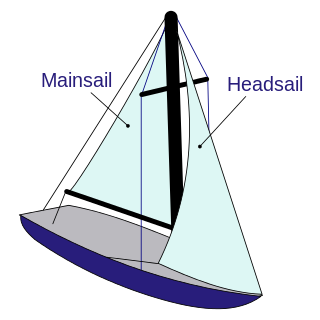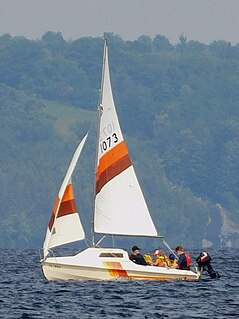Related Research Articles

A sailboat or sailing boat is a boat propelled partly or entirely by sails and is smaller than a sailing ship. Distinctions in what constitutes a sailing boat and ship vary by region and maritime culture.

A sail plan is a description of the specific ways that a sailing craft is rigged. Also, the term "sail plan" is a graphic depiction of the arrangement of the sails for a given sailing craft.

A dinghy is a type of small boat, often carried or towed by a larger vessel for use as a tender. Utility dinghies are usually rowboats or have an outboard motor. Some are rigged for sailing but they differ from sailing dinghies, which are designed first and foremost for sailing. A dinghy's main use is for transfers from larger boats, especially when the larger boat cannot dock at a suitably-sized port or marina.

A cutter is a type of watercraft. The term has several meanings. It can apply to the rig of a sailing vessel, to a governmental enforcement agency vessel, to a type of ship's boat which can be used under sail or oars, or, historically, to a type of fast-sailing vessel introduced in the 18th century, some of which were used as small warships.
The Fatty Knees fibreglass sailing dinghies were designed by Lyle Hess (1912–2002). Produced in 7’ (2.1m), 8’ (2.4m) and 9’ (2.7m) long models. The 8’ model has a 4’ (1.2m) beam. Primarily designed as a yacht tender with good rowing and towing characteristics, the boat can be sailed, with enough width in the beam to provide stability.

Otter is a classification referring to a particular design for a two-man sailing dinghy with a glass fibre hull. Its rig consists of a main, a jib and an optional symmetric spinnaker. The hull dimensions are 11 ft 11 in length and 4 ft 10 in beam. The boat has a draft of 3 ft 6 in with the centreboard down. The sail area is 75 sq. ft. The class symbol is a stylised glass bubble; due to the original lightweight "cigar box cedar" construction of the prototypes, the name 'Bubble' was first used for the boat. John Baker obtained the plans for an expanded version of the boat in G.R.P. and hence renamed the boat 'Glass Bubble'. After being put into production by Baker, the name 'Otter' was adopted; coming from the river of the same name in East Devon, close to where the boat was manufactured.

The word Drascombe is a trademark that was first registered by John Watkinson who applied it to a series of sailing boats which he designed and built in the period 1965–79 and sold in the United Kingdom (UK). They comprised the Coaster, Cruiser Longboat, Dabber, Drifter, Driver, Gig, Launch, Longboat, Lugger, Peterboat, Scaffie, Scaith and Skiff, together with a few other one-offs. They have wide and deep cockpits, adaptable boomless rigs and high bulwarks.

The Jacksnipe is a two-man racing sailing dinghy with a single trapeze for the crew and symmetrical spinnaker.

A trailer sailer is a type of sailboat that has been designed to be easily transported using a boat trailer towed by an automobile. They are generally larger than a sailing dinghy. Trailer sailers include day sailers and small cabin cruisers, suitable for living on.

Tongkang or "Tong'kang" refers to several type of boats used to carry goods along rivers and shoreline in Maritime Southeast Asia. One of the earliest record of tongkang comes from 15th century Malay Annals. One passage mentioned it as being used by Majapahit empire during the 1350 attack on Singapura.

The SCAMP is a wooden or fiberglass hulled Balanced Lug rigged sailing dinghy. The boat is 11 ft 11 in (3.63 m) long, and capable of accommodating four persons on a daysail or one to two for overnighting or extended cruising. Craig Wagner and Josh Colvin, editors of Small Craft Advisor Magazine, teamed up with noted New Zealand boat designer, John Welsford, to create what they call a "Mini Microcruiser" sailboat. Welsford considers it possibly the best boat he's designed, based on "suitability for purpose". Some early plans details received subsequent revisions by Kees Prins and the Northwest Maritime Center. While no particular feature of the boat is unprecedented, the combination of design elements has produced a "new genre of sailboat".
The following outline is provided as an overview of and topical guide to sailing:

The Drascombe Lugger is a British trailerable sailboat that was designed by John L. Watkinson and first built in 1968.
The Shrimp is a Canadian dinghy that was designed by Hubert Vandestadt and Fraser McGruer and first built in 1972. The boat was designed to employed as a powered yacht tender, a rowboat or as a sailing dinghy.
The Blue Crab 11, also called the Gloucester 11, is an American utility dinghy that can be rowed, used as a motorboat or as a sailing dinghy. It was designed by Harry R. Sindle and first built in 1971. The design is named for the family of crustaceans.
The Skunk 11 is a Canadian utility dinghy that can be rowed, used as a motorboat, fishing boat or as a sailing dinghy. It was designed by Hubert Vandestadt and first built in 1969.
The Drascombe Scaffie, now marketed as the Devon Scaffie, is a British trailerable sailboat that was designed by John L. Watkinson and first built in 1978. The modern Scaffie is based upon a traditional British boat design that dates back several hundred years.
The Leeward 16 is an American sailing dinghy that was designed by Luger Industries and first built in 1962.

The Mistral 16 is a Canadian sailing dinghy that was designed as a daysailer and first built in 1980.
The Sea Pearl 21 is an American trailerable sailboat or sailing dinghy, that was designed by Ron Johnson as an daysailer and first built in 1982.
References
- 1 2 3 Seahopper Folding Boats
- ↑ Carrie Lennard, commenting on an article at around Wellington http://www.aroundwellington.co.uk/wellington-boats-travel-the-world
- ↑ Duncan, Kent (August 2015). "Folding Tenders" (PDF). Yachting Monthly : 58–64. Retrieved 28 October 2016.